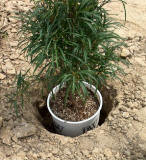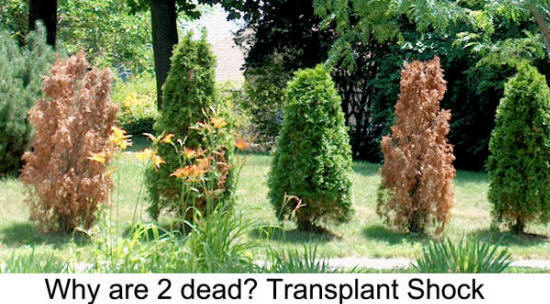By far, the number one reason for the
death of transplanted nursery stock is a phenomenon called
transplant shock. It is extremely rare (I would say impossible but
there may be an exception somewhere out
there in the world.) for a recently transplanted, otherwise
healthy plant to die of insect or disease shortly after
being moved. Within the first two seasons, and sometimes
more, if plants die, it is usually because of transplant
 shock.
shock.
So, what does that term mean? Well, whenever a plant is
moved, no matter how careful we are, it loses roots. The
damage can be minimized but it
cannot be totally avoided.
For a plant to be healthy and
thrive, it
must maintain a required balance between the volume of roots
and the amount of stems and leaves. When this balance is
disturbed, the plant will be under stress i.e. in shock,
until it can be restored. That means that the plant has to
re-grow new roots, drop some of its top growth or both to
achieve equilibrium again.
The key to re-establishing the root
system will be water relations. The soil needs to be moist
enough to support the growth of tiny hair roots which do
most of the work in transporting water and nutrients into
the plant. Then, larger root branches must be re-established
over time. In order for this process to work, not only must
there be water but there must also be adequate oxygen in the
soil to encourage root growth. So, the root zone needs to be
kept moist but not waterlogged.

At times, even the best of care will not be enough to
overcome transplant shock. If the root system was severely
damaged during transplanting, if the plant was installed
incorrectly or if the plant came from the nursery in poor
condition, it may never recover. It is not uncommon to see
larger trees hold on for several years and then finally give
up the ghost because they never recovered from
transplanting.



